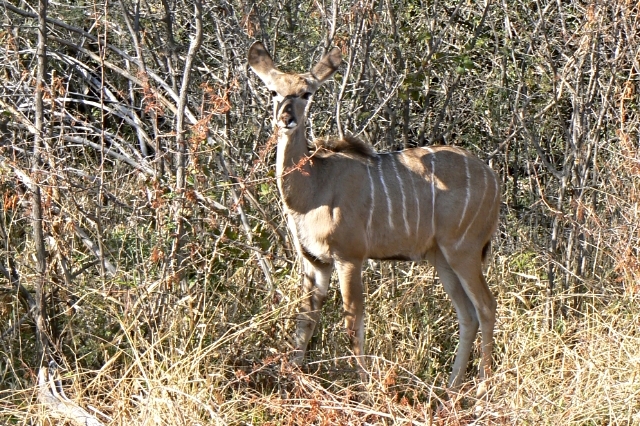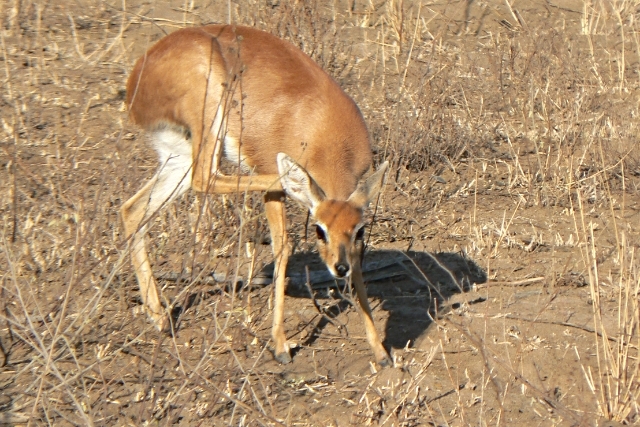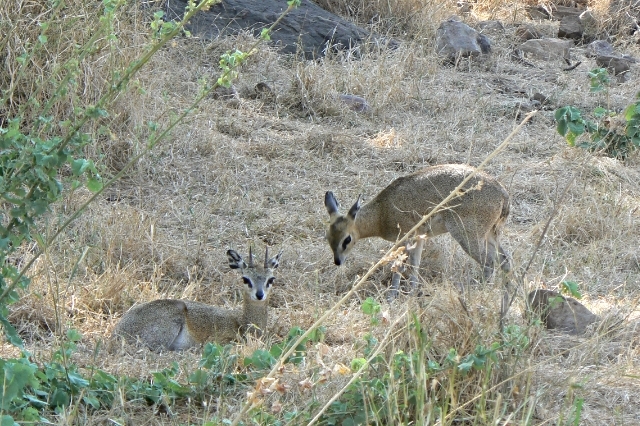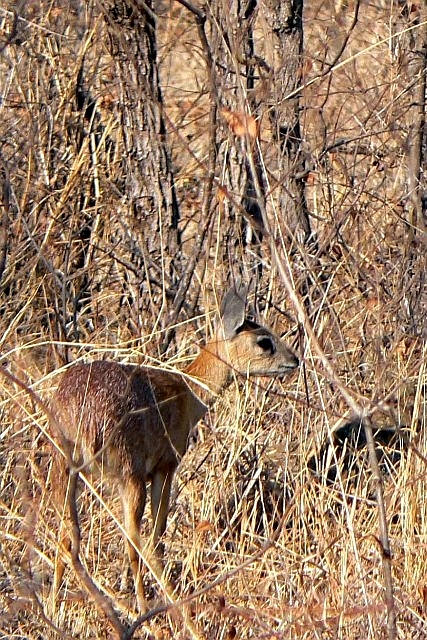Greater Kudu Tragelaphus strepsiceros

Marakele National Park, 18 August 2014

Marakele National Park, 18 August 2014
Body Length: 185-245 cm
Shoulder Height: 100-160 cm
Tail Length: 30-55 cm
Weight: 120-315 kg
The short, smooth coat varies in general colour from tan-grey to bluish grey in colour. There are numerous white markings, including 6-10 vertical stripes along the sides, a chevron between the eyes, and cheek spots. On the neck and shoulders is an erectile crest, while underneath a mane extends along the throat. The black-tipped, bushy tail is white underneath, and there are black garters on the upper legs. The ears are large and round. The spiralled horns are found only in males and have up to 3 full turns, diverging slightly as they slant back from the head. They can grow 100-140 cm long.
Gestation Period: 7-9 months
Young per Birth: 1
Weaning: After 6 months
Sexual Maturity: Females at 15-21 months, males at 21-24 months
Life span: Up to 23 years
Females separate themselves from the herd just before giving birth, leaving the calf lying in concealment. After the calf has matured slightly, the mother will return with her baby to the herd. The majority of births occur from January to March, the wet season.
Greater kudu may be active throughout the 24-hour day. The large ears are extremely sensitive to noise, making these shy antelope difficult to approach. Under normal circumstance, kudu will sneak away and hide from potential enemies. When startled, however, they flee with large jumps with their tails rolled upwards and forwards. Kudu often stop and look back after a running for a short distance - a frequently fatal habit. Despite their large size, kudu are accomplished jumpers, with records of heights of over 2.5 m being cleared with ease. Herds disperse during the rainy season when food is plentiful, while as the dry season reaches its peak, there becomes a high concentration in favourable areas. Greater kudu are not territorial, although they do have 'home' areas. Maternal herds have home ranges of approximately 4 square kilometers which overlap with those of other groups. Home ranges of adult males are about 11 square kilometers, and generally encompass the ranges of two or three female groups. Population densities vary from 1.9-3.2 animals per square kilometer. The spiral horns are so well developed for wrestling that they can sometimes become so severely interlocked that the two animals fighting cannot release each other, and thus both die. Greater kudu have a wide repertoire of vocalizations, including barks, grunts, hooting bleats, and a strangulated whimper.
Family group: Small single sex groups up to 10, though congregations of 20-30 individuals have been recorded.
Diet: Leaves and grasses
Main Predators: Lion, Wild dog, leopard.
Historically, the Greater Kudu occurred over much of eastern and southern Africa, from Chad nearly to the Red Sea, south to the Eastern Cape, west to Namibia and north to mid-Angola. While it has disappeared from substantial areas, mainly in the north of its range, it generally persists in a greater part of its former range than other large antelope species, as a result of its secretiveness and its ability to survive in settled areas with sufficient cover. Kudu are distributed widely in South Africa.
Preferred habitat includes mixed scrub woodland (it is one of the few large mammals that thrives in settled areas - in the scrub woodland and bush that reclaims abandoned fields and degraded pastures), acacia, and mopane bush on lowlands, hills, and mountains. Kudu prefers dense bush, wooded foot hills of mountain areas, open Knobthorn woodlands in the Kruger National Park. Kudu are browsers; they can exist for long periods without drinking, obtaining sufficient moisture from their food, but become water dependent at times when the vegetation is very dry.










